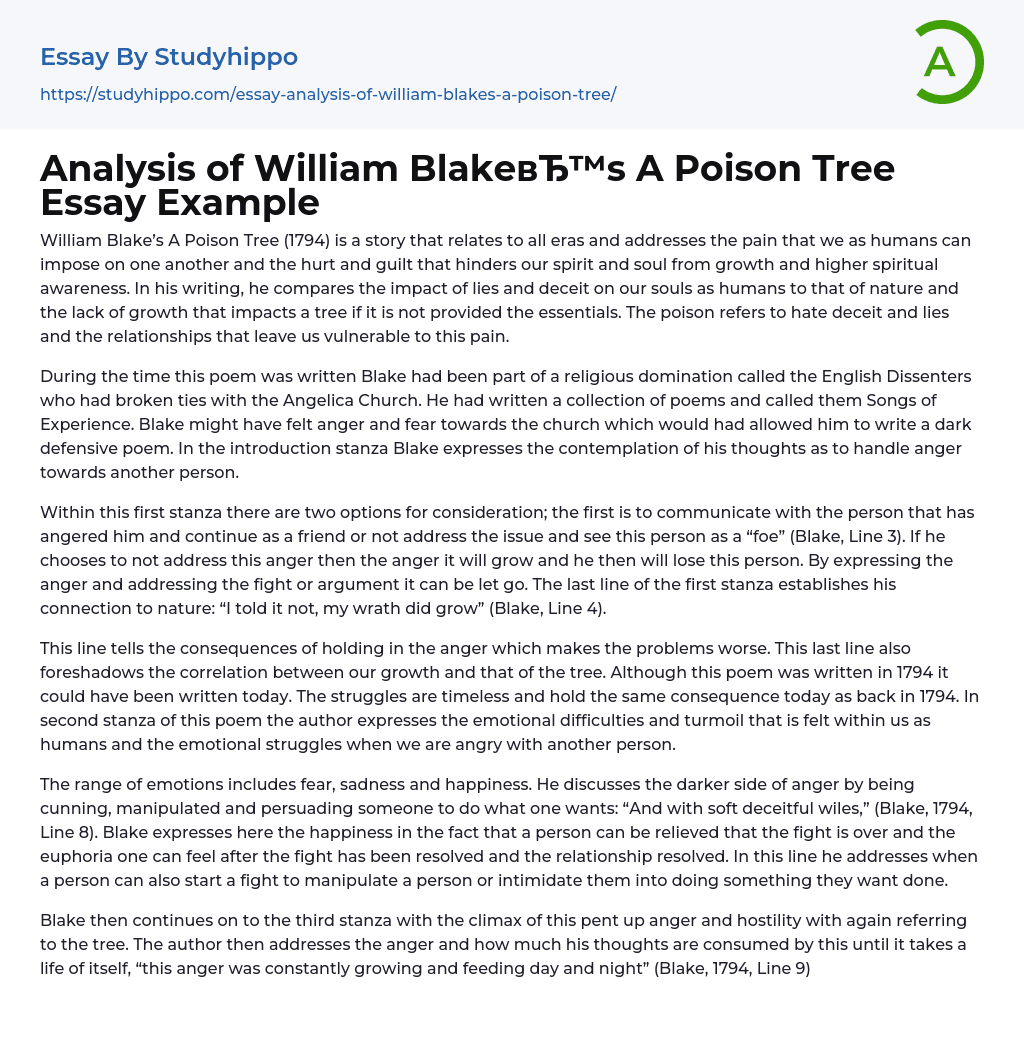In 1794, William Blake wrote a poem called A Poison Tree, which delves into the concept of how we as humans can cause harm to one another. It highlights the subsequent feelings of pain, guilt, and spiritual stagnation that arise from such actions. Blake connects the damaging impact of falsehoods and deception on our souls to the lack of development observed in a tree deprived of its necessary requirements. The title serves as a metaphor for the poisonous nature of hate, deceit, and lies within relationships that make us vulnerable to this suffering.
During the composition of this poem, Blake was a member of the English Dissenters, a religious group that had broken away from the Angelica Church. He penned a series of poems called Songs of Experience. It is likely that Blake experienced resentment and apprehension towards the church, w
...hich motivated him to write a defensive and somber piece. In the first stanza, Blake contemplates how to handle his anger towards another individual.
The poem's first stanza presents two choices for handling anger towards someone. The first choice involves communication and preserving the friendship, while the second choice entails ignoring the issue and perceiving the person as an enemy. Opting to ignore the anger allows it to intensify, eventually leading to losing the person. Conversely, expressing and confronting the fight or argument can provide a release. The concluding line of this stanza emphasizes the poet's affinity with nature as he acknowledges that his anger remained hidden, fostering its growth.
Written in 1794, this poem explores the consequences of suppressing anger and how it can worsen problems. The final lin
highlights a connection between personal growth and the growth of a tree. Surprisingly, these struggles remain relevant today with the same consequences as they did in 1794. The second stanza delves into the emotional turmoil humans experience when angry with others.
The author explores various emotions like fear, sadness, and happiness in this text. They also highlight the negative qualities of anger, such as its ability to be cunning and manipulative for personal gain. Blake's quote "And with soft deceitful wiles," (Blake, 1794, Line 8) illustrates the satisfaction derived from resolving a conflict or fight through deceptive means. Moreover, the author recognizes that one can deliberately provoke a fight to manipulate or intimidate others into meeting their desires.
Blake then continues to the third stanza, where he expresses the climax of his anger and hostility by again referencing the tree. The author acknowledges how consumed his thoughts are by this anger, stating that it grows and feeds constantly day and night (Blake, 1794, Line 9). He further employs the symbolism of an apple in the tenth line of his poem, describing how the anger eventually bears a bright apple. Throughout the poem, Blake consistently portrays the anger and its effects as comparable to a tree.
This line is highly symbolic, representing its own existence and the immense energy it possesses. The apple appears to the reader as a manifestation of anger, assuming a tangible form. Additionally, the apple serves as a means for the reader to comprehend the gravity and influence of anger upon us. It is no longer merely part of the tree, but rather an independent entity. Blake proceeds to
discuss the apple's ownership, highlighting that his enemy recognized it as his own apple – a symbol of distress, torment, and suffering. This is where the concept of ownership and responsibility is conveyed in the writing: “And he knew that it was mine” (Blake, 1794, Line 12). In the final stanza, Blake leaves the reader to come up with their own interpretation of how this situation concludes. He creates a scene in which the enemy confronts him, set against a dark night that obscures clear vision, as expressed in this verse: “When the night had veiled the pole;” (Blake, 1794, Line 14). The poem then mentions the welcoming of morning, implying relief from the darkness previously experienced.
Blake (1794) writes in his poem, "In the morning glad I see/ My Foe outstretched beneath the tree" (Line 14-15), expressing satisfaction as the enemy is killed by the tree's poison. The poem narrates the development of an argument, providing insights into opportunities for resolving the conflict and emphasizing the importance of addressing it promptly to avoid dire consequences. It serves as an enlightening piece that urges readers to tackle problems from the outset, preventing them from escalating into irreparable damage.
- Ambition essays
- Anger essays
- Betrayal essays
- Boredom essays
- Confidence essays
- Courage essays
- Desire essays
- Disgrace essays
- Doubt essays
- Empathy essays
- Fairness essays
- Fear essays
- Feeling essays
- Forgiveness essays
- Grief essays
- Guilt essays
- Happiness essays
- Harmony essays
- Hate essays
- Honesty essays
- Honor essays
- Hope essays
- Humanity essays
- Inspiration essays
- Kindness essays
- Laughter essays
- Loneliness essays
- Lost essays
- Loyalty essays
- Need essays
- Passion essays
- Pressure essays
- Pride essays
- Regret essays
- Respect essays
- Responsibility essays
- Sarcasm essays
- Shame essays
- Suffering essays
- Suspense essays
- Tolerance essays
- Adult essays
- Aggression essays
- Altruism essays
- Archetype essays
- Behavior essays
- Certainty essays
- Conformity essays
- Deception essays
- Human Behavior essays




